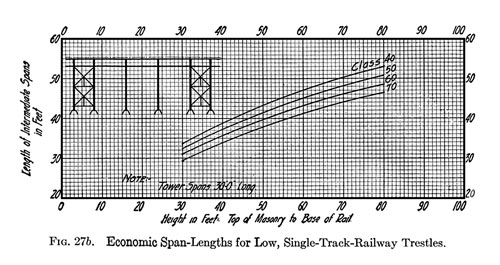| 252 | ECONOMICS OF BRIDGEWORK | Chapter XXVII |
|
ing slightly with the height; but the resulting error in the total weights of metal will be negligible. For double-track-railway trestles consisting of alternate tower-spans and intermediate-spans, and having two planes of longitudinal bracing, the ratio of intermediate-span-length to tower-span-length is a trifle less than for the single-track trestle, the values for Class 40 being about 1.08 for a 60-foot height, and 1.55 for a 240-foot height. The corresponding values for Class 70 are 1.05 and 1.34. The economic distances from center to center of towers are 85 or 90 per cent of those for a single-track trestle. The lengths of tower-spans are about the same as for the single-track trestles, but the lengths of intermediate-spans are only about 80 per cent as great.
The economics for low, double-track-railway trestles of the type shown in Fig. 27b are as follows: The lengths of the tower-spans will be identical with those for like single-track-railway trestles, and those of the intermediate spans about ninety per cent of the corresponding lengths for same. Strictly speaking, the costs of the pedestals should be figured in comput- ing the economic span-lengths, but for bare rock foundations they are insignificant and, therefore, negligible; for pile foundations and spread foundations on soft soil they are almost constant per lineal foot of structure, irrespective of the span-lengths, and consequently also negligible; and it is only when the pedestals have to penetrate deeply into the ground and rest on fairly hard soil that their cost becomes influential. Their effect is to increase the economic lengths of both the intermediate and the tower spans, although probably not more than a few feet. The economic span-lengths for highway trestles with two lines of main girders will generally be a trifle greater than those for Class 40, single- track-railway trestles; and for like structures with several lines of main girders they will be somewhat larger than those for Class 40, double-track- |
